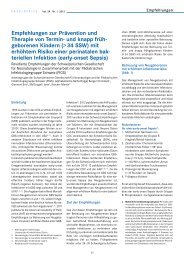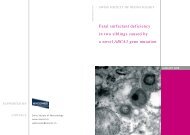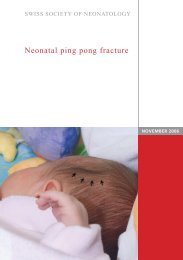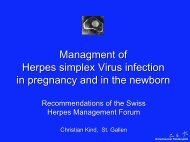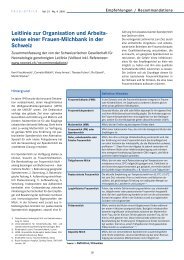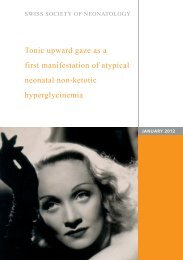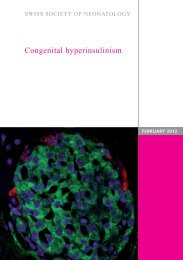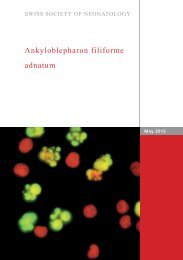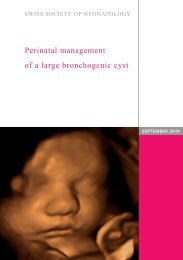Oculocutaneous albinism in a set of triplets - Swiss Society of ...
Oculocutaneous albinism in a set of triplets - Swiss Society of ...
Oculocutaneous albinism in a set of triplets - Swiss Society of ...
You also want an ePaper? Increase the reach of your titles
YUMPU automatically turns print PDFs into web optimized ePapers that Google loves.
SWISS SOCIETY OF NEONATOLOGY<br />
<strong>Oculocutaneous</strong> <strong>alb<strong>in</strong>ism</strong><br />
<strong>in</strong> a <strong>set</strong> <strong>of</strong> <strong>triplets</strong><br />
MAY 2010
Das-Kundu S, Tomaske M, Michels R, Weibel L,<br />
Bartholdi D, Arlettaz Mieth R, Cl<strong>in</strong>ic for Neonatology<br />
(DKS, AMR), University Hospital Zurich, Cl<strong>in</strong>ic for<br />
Neonatology (TM), Triemli Hospital, 3 Department <strong>of</strong><br />
Ophthalmology (MR), Department <strong>of</strong> Dermatology (WL),<br />
Institute for Medical Genetics (BD), University Hospital<br />
Zurich<br />
© <strong>Swiss</strong> <strong>Society</strong> <strong>of</strong> Neonatology, Thomas M Berger, Webmaster<br />
2
3<br />
A 30-year-old Sri Lankan G2/P1 conceived <strong>triplets</strong> (tri-<br />
chorial, triamniotic) follow<strong>in</strong>g hormone stimulation.<br />
Prophylactic lung maturation with steroids was carried<br />
out <strong>in</strong> the 27th week <strong>of</strong> gestation. Premature rupture<br />
<strong>of</strong> membranes <strong>in</strong> triplet B occurred at 29 2/7 weeks<br />
<strong>of</strong> gestation. Tocolysis and erythromyc<strong>in</strong> were started.<br />
The contractions persisted and the <strong>triplets</strong> (two males<br />
and one female) were delivered by cesarean section at<br />
30 3/7 weeks <strong>of</strong> gestation. Anthropometric measurements<br />
for all three <strong>in</strong>fants were with<strong>in</strong> normal limits.<br />
All three had mild respiratory distress and required<br />
nasal CPAP and oxygen on the first day <strong>of</strong> life.<br />
Already at birth, it was noted that the sk<strong>in</strong> color <strong>of</strong><br />
triplet A (male) and triplet C (female) was very light <strong>in</strong><br />
comparison to that <strong>of</strong> triplet B. Both babies had blond<br />
hair and eyelashes. Dur<strong>in</strong>g the follow<strong>in</strong>g weeks, this<br />
phenomenon became <strong>in</strong>creas<strong>in</strong>gly apparent so that<br />
the diagnosis <strong>of</strong> <strong>alb<strong>in</strong>ism</strong> was suspected (Fig. 1). The<br />
parents, both Sri Lankan, had dark hair and were nonconsangu<strong>in</strong>eous.<br />
The mother had normally pigmented<br />
sk<strong>in</strong>, the father was fair. The family pedigree especially<br />
on the paternal side consisted <strong>of</strong> several generations<br />
with blue eyes and white hair (Fig. 2). On the<br />
maternal side, an aunt and an uncle have blue eyes<br />
and light sk<strong>in</strong>. The cl<strong>in</strong>ical course <strong>of</strong> the babies was<br />
uneventful and they were transferred to a neighbor<strong>in</strong>g<br />
hospital on day 17 <strong>of</strong> life.<br />
CASE REPORT
An ophthalmological exam<strong>in</strong>ation carried out <strong>in</strong> the<br />
4th week <strong>of</strong> life revealed blue irises, pale pigment epithelium,<br />
small, pale papillae, and an absent macular<br />
reflex consistent with macular hypoplasia <strong>in</strong> the case<br />
<strong>of</strong> triplet A and C thereby confirm<strong>in</strong>g the diagnosis <strong>of</strong><br />
oculocutaneous <strong>alb<strong>in</strong>ism</strong>. Triplet B had a normally pigmented<br />
and vascularized ret<strong>in</strong>a with a positive macular<br />
reflex (Fig. 3).<br />
Cerebral ultrasound showed mild dilatation <strong>of</strong> the<br />
lateral ventricles <strong>in</strong> the case <strong>of</strong> triplet A and C and a<br />
small right-sided subependymal bleed <strong>in</strong> the case <strong>of</strong><br />
triplet B. All three babies had mild neutropenia, with<br />
absolute neutrophil counts rang<strong>in</strong>g between 1160 and<br />
1300 per µL. Platelet counts were normal. The babies<br />
were discharged at the age <strong>of</strong> 8 weeks (38 5/7 weeks<br />
post menstrual age) with normal weight, length and<br />
head circumference for age. The neurological exam<strong>in</strong>ation<br />
was normal and there was no evidence <strong>of</strong> nystagmus<br />
<strong>in</strong> triplet A or C.<br />
At follow-up at a corrected age <strong>of</strong> 3 months (Fig. 4),<br />
both <strong>triplets</strong> A and C showed a pendular nystagmus<br />
which was more prom<strong>in</strong>ent <strong>in</strong> the female triplet C (movie).<br />
The male triplet showed some darken<strong>in</strong>g <strong>of</strong> the<br />
hair, the female <strong>in</strong>fant rema<strong>in</strong>ed blond. In order to reduce<br />
photophobia and to correct for a refractive error<br />
(extensive hyperopia), special dark glasses were recommended<br />
at this time. The parents were advised to prevent<br />
exposure to sun with the use <strong>of</strong> cloth<strong>in</strong>g, hats and<br />
4
5<br />
sunscreens with physical filters and SPF 50. Genetic<br />
counsel<strong>in</strong>g <strong>of</strong> the family was carried out. Chromosome<br />
and molecular genetic analyses <strong>in</strong> the affected<br />
babies and parents were recommended but have not<br />
been performed until now.<br />
Triplets A-C (from left to right) at the age <strong>of</strong> 3 weeks.<br />
Fig. 1
Fig. 2<br />
Fig. 3<br />
A B<br />
Family pedigree.<br />
Ophthalmological exam<strong>in</strong>ation at 4 weeks <strong>of</strong> age:<br />
note color <strong>of</strong> eye lashes and <strong>in</strong>creased translucency<br />
<strong>of</strong> the iris.<br />
6
7<br />
Affected <strong>in</strong>fants at the age <strong>of</strong> 3 months<br />
(triplet A: left, triplet C: right).<br />
Fig. 4
DISCUSSION Alb<strong>in</strong>ism can affect people <strong>of</strong> all ethnic backgrounds.<br />
Appro ximately 1 <strong>in</strong> 17’000 people has one <strong>of</strong> the types<br />
<strong>of</strong> <strong>alb<strong>in</strong>ism</strong>, ocular or oculocutaneous (1,2).<br />
<strong>Oculocutaneous</strong> <strong>alb<strong>in</strong>ism</strong> (OCA) describes a group <strong>of</strong> con-<br />
genital heterogeneous disorders <strong>of</strong> melan<strong>in</strong> biosynthesis.<br />
The structure and number <strong>of</strong> melanocytes are normal. At<br />
least four genes are responsible for the different types <strong>of</strong><br />
OCA (3).<br />
OCA1 is caused by mutations <strong>in</strong> the tyros<strong>in</strong>ase gene<br />
(TYR) on chromosome 11q14.3. Tyros<strong>in</strong>ase catalyzes the<br />
first two steps <strong>in</strong> the melan<strong>in</strong> biosynthesis pathway. Mutations<br />
completely abolish<strong>in</strong>g tyros<strong>in</strong>ase activity result<br />
<strong>in</strong> OCA1A, while mutations ma<strong>in</strong>ta<strong>in</strong><strong>in</strong>g some enzyme<br />
activity result <strong>in</strong> OCA1B allow<strong>in</strong>g some accumulation<br />
<strong>of</strong> melan<strong>in</strong> pigment over time. Mutations <strong>in</strong> the OCA2<br />
gene <strong>in</strong> the region <strong>of</strong> chromosome 15q11.2-q12 cause<br />
the OCA2 phenotype. The OCA2 prote<strong>in</strong> is important for<br />
normal biogenesis <strong>of</strong> melanosomes and for normal process<strong>in</strong>g<br />
and transport <strong>of</strong> melanosomal prote<strong>in</strong>s. OCA3<br />
is caused by mutations <strong>in</strong> the tyros<strong>in</strong>ase-related prote<strong>in</strong><br />
1 (TYRP1), another enzyme <strong>in</strong> the melan<strong>in</strong> biosynthesis<br />
pathway. F<strong>in</strong>ally, mutations <strong>in</strong> the membrane-associated<br />
transporter prote<strong>in</strong> gene (MATP) is responsible for OCA4.<br />
The MATP prote<strong>in</strong> plays an important role <strong>in</strong> pigmentation<br />
and functions as a membrane transporter <strong>in</strong> melanosomes.<br />
8
9<br />
The degree <strong>of</strong> sk<strong>in</strong> and hair hypopigmentation varies<br />
with the type <strong>of</strong> <strong>alb<strong>in</strong>ism</strong>. In OCA1A, hair, eyelashes and<br />
eyebrows are white, sk<strong>in</strong> is white and does not tan. Irises<br />
are light blue to p<strong>in</strong>k and translucent. Pigment does not<br />
develop. Visual acuity is 1/10 or less and photophobia is<br />
<strong>in</strong>tense. In OCA1B, the hair and sk<strong>in</strong> may develop some<br />
pigment with time (1-3 years), blue irises may change to<br />
green/brown. Visual acuity can reach 2/10. In OCA2, the<br />
amount <strong>of</strong> cutaneous pigment may vary, and newborns<br />
almost always have pigmented hair. Nevi and ephilids are<br />
common. Iris color varies and the p<strong>in</strong>k eyes seen <strong>in</strong> OCA1<br />
are absent. Visual acuity is better than <strong>in</strong> OCA1 and can<br />
reach 3/10. OCA3 results <strong>in</strong> red OCA <strong>in</strong> Africans who<br />
have red hair and reddish brown sk<strong>in</strong>. Visual anomalies<br />
are not always detectable. OCA4 is cl<strong>in</strong>ically similar to<br />
OCA2.<br />
All types <strong>of</strong> OCA and ocular <strong>alb<strong>in</strong>ism</strong> have similar ocular<br />
f<strong>in</strong>d<strong>in</strong>gs <strong>in</strong>clud<strong>in</strong>g vary<strong>in</strong>g degrees <strong>of</strong> congenital nystagmus,<br />
iris hypopigmentation lead<strong>in</strong>g to iris translucency,<br />
reduced pigmentation <strong>of</strong> the ret<strong>in</strong>al pigment epithelium,<br />
foveal hypoplasia, reduced visual acuity <strong>in</strong> the range <strong>of</strong><br />
20/60 to 20/400, refractive errors and sometimes color<br />
vision impairment. Photophobia may be prom<strong>in</strong>ent. Iris<br />
translucency is demonstrated by slit lamp exam<strong>in</strong>ation.<br />
A characteristic f<strong>in</strong>d<strong>in</strong>g is misrout<strong>in</strong>g <strong>of</strong> the optic nerves,<br />
consist<strong>in</strong>g <strong>of</strong> an excessive cross<strong>in</strong>g <strong>of</strong> fibers <strong>in</strong> the optic<br />
chiasma which can result <strong>in</strong> strabismus and reduced
10<br />
stereo scopic vision. This can be demonstrated by mono-<br />
cular visual evoked potentials.<br />
Diagnosis <strong>of</strong> OCA is based on cl<strong>in</strong>ical f<strong>in</strong>d<strong>in</strong>gs <strong>of</strong> hypopig-<br />
mentation <strong>of</strong> the sk<strong>in</strong> and hair <strong>in</strong> addition to characteri-<br />
stic ocular symptoms. However, due to the cl<strong>in</strong>ical over-<br />
lap between the OCA subtypes, molecular diagnosis is<br />
necessary to establish the gene defect and thus the OCA<br />
subtype.<br />
All 4 types <strong>of</strong> OCA are <strong>in</strong>herited as autosomal recessive<br />
disorders. The parents <strong>of</strong> an affected child are obligate<br />
carriers, the recurrence risk for another affected child<br />
is 25% and healthy sibl<strong>in</strong>gs are at a 67% risk <strong>of</strong> be<strong>in</strong>g<br />
carriers. Offspr<strong>in</strong>g <strong>of</strong> an affected person are obligate car-<br />
riers. In most cases, there is no family history <strong>of</strong> <strong>alb<strong>in</strong>ism</strong>.<br />
The condition does occur <strong>in</strong> <strong>in</strong>dividuals <strong>of</strong> 2 successive<br />
generations <strong>of</strong> a family, so called “pseudodom<strong>in</strong>ance”<br />
if an affected person has children with a carrier. Carrier<br />
detection and prenatal diagnosis are possible. In African<br />
populations, there is a high frequency <strong>of</strong> the OCA2 mutant<br />
alleles, hence affected patients <strong>in</strong> several genera-<br />
tions may be seen.<br />
Alb<strong>in</strong>ism may be part <strong>of</strong> an underly<strong>in</strong>g syndrome (2), e.g.,<br />
Hermansky-Pudlak syndrome (severe immunologic deficiency,<br />
<strong>in</strong>terstitial lung fibrosis, granulomatous colitis and<br />
mild bleed<strong>in</strong>g problems), Chediak-Higashi syndrome (<strong>in</strong>creased<br />
susceptibility to bacterial <strong>in</strong>fections, prolonged<br />
bleed<strong>in</strong>g time, peripheral neuropathy), Griscelli syndrome
11<br />
(immune impairment or neurological deficit, hypopig-<br />
mentation <strong>of</strong> sk<strong>in</strong> and hair), or Wardenburg syndrome<br />
Type ll (sensory deafness and partial <strong>alb<strong>in</strong>ism</strong>).<br />
The management <strong>of</strong> OCA <strong>in</strong>cludes management <strong>of</strong> eye<br />
and sk<strong>in</strong> problems (2). Reduced visual acuity can be helped<br />
with glasses, possibly bifocals and dark glasses or<br />
photochromic lenses for photophobia. Nystagmus may<br />
be helped with contact lenses or surgery <strong>of</strong> the eye<br />
muscles. Children require special attention at school.<br />
Regard<strong>in</strong>g the sk<strong>in</strong>, most people with severe forms <strong>of</strong><br />
OCA do not tan and get easily sunburned. Those forms<br />
with a little pigment development with age may be less<br />
affected by the sun. Sunscreens with a sun protection<br />
factor <strong>of</strong> at least 30 and ideally conta<strong>in</strong><strong>in</strong>g physical filters<br />
are recommended (3).<br />
Lifespan for patients with OCA is normal (2). General<br />
medical problems are not <strong>in</strong>creased compared to the<br />
general population, but the <strong>in</strong>cidence <strong>of</strong> sk<strong>in</strong> cancer,<br />
squamous cell carc<strong>in</strong>oma and basal cell carc<strong>in</strong>oma <strong>in</strong><br />
particular, is higher <strong>in</strong>affected patients (23% to 34%)<br />
so that regular sk<strong>in</strong> checkups are necessary (3). Development<br />
and <strong>in</strong>telligence are normal (4).<br />
The type <strong>of</strong> OCA <strong>in</strong> our patients rema<strong>in</strong>s unclear. The<br />
family history and the <strong>in</strong>vestigations carried out suggest<br />
that the OCA <strong>in</strong> this family is an isolated entity without<br />
association with a syndrome. Molecular genetic analysis<br />
would help to determ<strong>in</strong>e the type <strong>of</strong> OCA and therefore<br />
the prognosis <strong>in</strong> this family..
REFERENCES<br />
1. Chiang P-W, Spector E, Tsai AC-H. <strong>Oculocutaneous</strong> <strong>alb<strong>in</strong>ism</strong><br />
spectrum. Am J Med Genet Part A 2009;149A:1590-1591<br />
2. Gronskov K, Brondum-Nielsen K. <strong>Oculocutaneous</strong> <strong>alb<strong>in</strong>ism</strong>.<br />
Orphanet J Rare Dis 2007;2:43<br />
3. Okulicz JF, Shah RS, Schwartz RA, Janniger CK. <strong>Oculocutaneous</strong><br />
<strong>alb<strong>in</strong>ism</strong>. J Eur Acad Dermatol Venereol 2003;17:251–256<br />
4. Kutzbach BR, MacDonald JT. Neurodevelopment <strong>in</strong> children<br />
with <strong>alb<strong>in</strong>ism</strong>. Ophthalmology 2008;115:1805-1808<br />
12
SUPPORTED BY<br />
CONTACT<br />
<strong>Swiss</strong> <strong>Society</strong> <strong>of</strong> Neonatology<br />
www.neonet.ch<br />
webmaster@neonet.ch<br />
concept & design by mesch.ch



